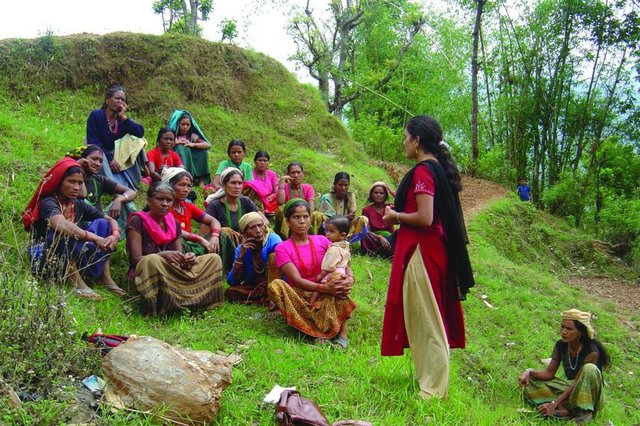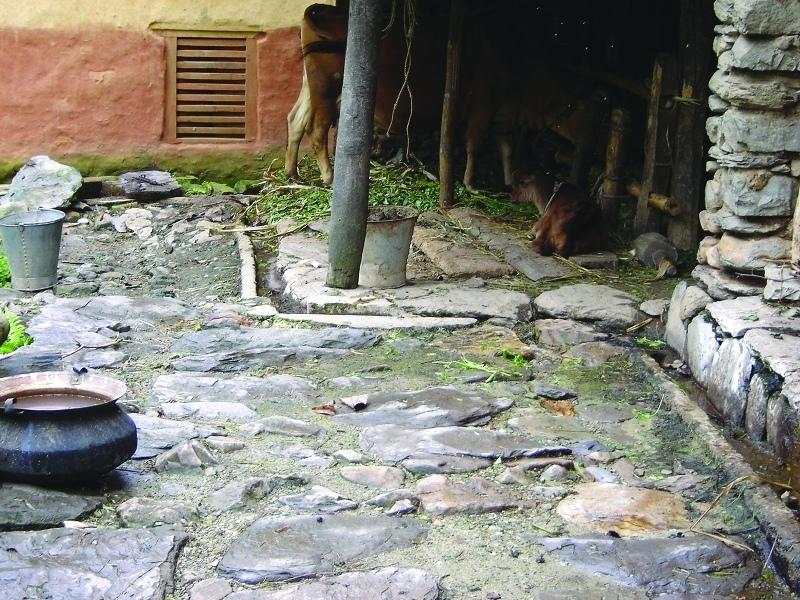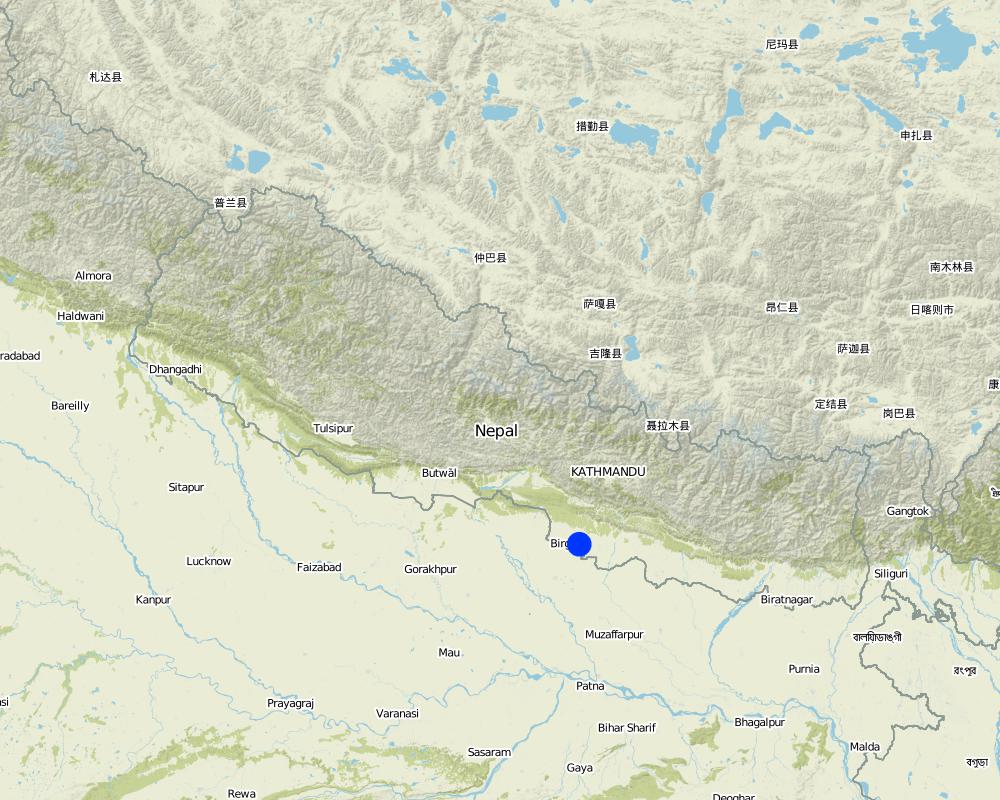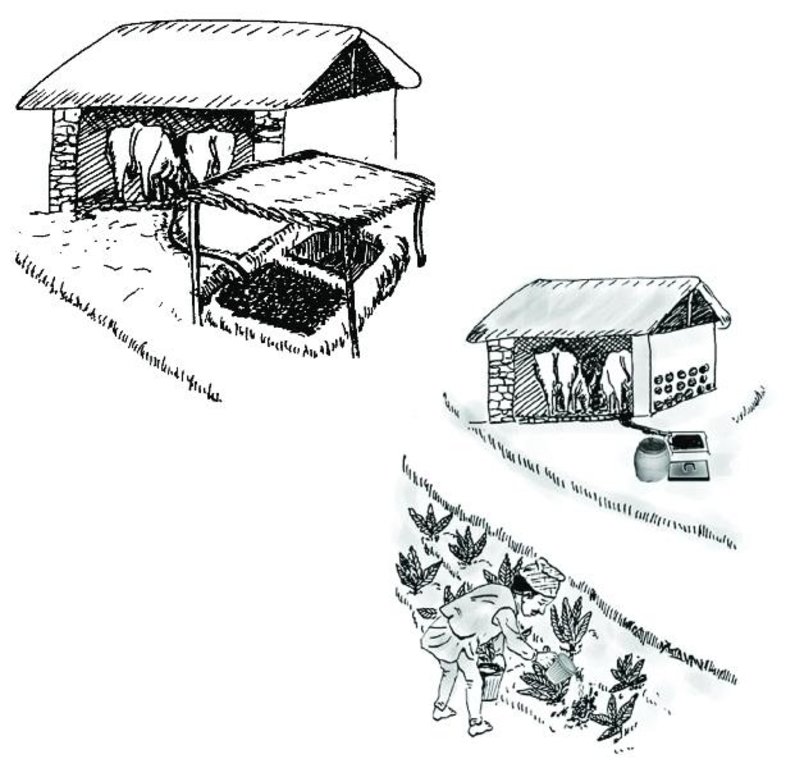Improved cattleshed for urine collection [النيبال]
- تاريخ الإنشاء:
- تحديث:
- جامع المعلومات: Richard Allen
- المحرر: –
- المراجعون: David Streiff, Alexandra Gavilano
Mutra sankalan ka lagi sudhariyeko goth (Nepali)
technologies_1752 - النيبال
عرض الأقسام
توسيع الكل طي الكل1. معلومات عامة
1.2 تفاصيل الاتصال بالأشخاص الرئيسيين لمصدر المعلومات والمؤسسات المشاركة في تقييم وتوثيق التقنية
متخصص في الإدارة المستدامة للأراضي:
Director
Soil Management Directorate, Department of Agriculture
النيبال
متخصص في الإدارة المستدامة للأراضي:
Team Leader
Sustainable Soil Management Programme
النيبال
اسم المشروع الذي سهّل توثيق/تقييم التقنية (إذا كان ذلك على صلة)
Sustainable Soil Management Programme, Nepal (SSMP)اسم المؤسسة (المؤسسات) التي سهلت توثيق/تقييم التقنية (إذا كان ذلك على صلة)
HELVETAS (Swiss Intercooperation)اسم المؤسسة (المؤسسات) التي سهلت توثيق/تقييم التقنية (إذا كان ذلك على صلة)
Department of Agriculture, Soil Management Directorate, Hariharbhawan Lalitpur (doasoil) - النيبال1.3 الشروط المتعلقة باستخدام البيانات الموثقة من خلال WOCAT
يوافق جامع المعلومات والشخص (لاشخاص) الرئيسي لمصدر المعلومات على الشروط المتعلقة باستخدام البيانات الموثقة من خلال WOCAT:
نعم
1.5 الإشارة إلى الاستبيان (الاستبيانات) حول مناهج الإدارة المستدامة للأراضي (موثقة باستخدام WOCAT)

Farmer field schools on integrated plant nutrient systems [النيبال]
Participatory and collaborative learning through the farmer field school approach
- جامع المعلومات: Richard Allen

Farmer-led experimentation [النيبال]
Participatory technology testing and adaptation through farmer-led experiments
- جامع المعلومات: Richard Allen

Farmer-to-farmer diffusion [النيبال]
Wider diffusion of sustainable soil management technologies through a demand responsive farmer-to-farmer diffusion approach
- جامع المعلومات: Richard Allen
2. وصف تقنيةالإدارة المستدامي للأراضي
2.1 وصف مختصر للتقنية
تعريف التقنية:
Collection of cattle urine in improved cattle sheds for use as liquid manure and organic pesticide
2.2 وصف تفصيلي للتقنية
الوصف:
Nitrogen is the most important macronutrient for plants, and high crop productivity can only be achieved by making sufficient nitrogen available to crops. Nitrogen is also the most limiting nutrient in farms across Nepal’s midhills. Traditionally farmers applied farmyard manure to fertilise their needs. In many places this is being supplemented or even entirely replaced by inorganic fertiliser - mainly urea. The price of inorganic fertiliser has increased continuously in recent years and it is only available in limited quantities in areas far from the roadheads. On the other hand, cultivation practices are intensifying with increased cropping intensities and more nutrient-demanding crops as, for example, local varieties are replaced by hybrids and new crops are grown. This can easily lead to declining soil fertility and nutrient mining if it is not compensated for by an equivalent increase in organic or mineral fertilisation.
Cattle urine is a viable alternative to mineral fertiliser. Of the nitrogen excreted by cattle, 60% is found in the urine and only 40% in dung. In traditional sheds, urine is left to be absorbed in the bedding material, while excess urine is channelled out of the shed and disposed of. The technology described here - improved cattle sheds- are designed for collecting the urine in a pit or drum. This pit is generally located in the shed itself or just outside connected to the drainage channel through a pipe and protected from rain and runoff. Where urine is collected for incorporation in farmyard manure, the pit may be directly connected to the manure pit or heap. Urine that is going to be used as liquid manure or organic pesticide has to be stored in a drum for fermentation.
A household with two cattle can save the equivalent of purchasing about 100 kg of urea over one year by applying urine either directly as liquid fertiliser or as a component in improved farmyard manure.
2.3 صور التقنية
2.5 البلد/المنطقة/المواقع التي تم تنفيذ التقنية فيها والتي يغطيها هذا التقييم
البلد:
النيبال
مزيد من التفاصيل حول الموقع:
Midhill districts of Nepal
Map
×3. تصنيف تقنية الإدارة المستدامي للأراضي
3.1 الغرض الرئيسي ( الأغراض الرئيسية) للتقنية
- Collect fertilizer
3.2 نوع (أنواع) استخدام الأراضي الحالية حيث يتم تطبيق التقنية

الأراضي الزراعية
- زراعة سنوية
التعليقات:
Major land use problems (compiler’s opinion): Intensifying cultivation practices with either 1) inadequate application of fertilisers leading to a decline in soil fertility and the mining of soil nutrients or 2) application of too much fertiliser causing environmental problems through excessive leaching, and losses of fertiliser in surface runoff and consequent eutrophication or nitrification of streams, ponds, or groundwater.
3.5 مجموعةالإدارة المستدامة للأراضي التي تنتمي إليها هذه التقنية
- الإدارة المتكاملة لخصوبة التربة
3.6 التدابير التقنية في مجال إلادارة المستدامة للأراضي

التدابير الإدارية
- M6: إدارة النفايات (إعادة التدوير أو إعادة الاستخدام أو التقليل)
التعليقات:
Main measures: management measures
3.7 الأنواع الرئيسية من تدهور الأراضي التي تناولتها التقنية

التدهور الكيميائي للتربة
- (Cn): تراجع الخصوبة وانخفاض محتوى المادة العضوية (غير ناتج عن الانجراف)
3.8 منع أو حد أو عكس تدهور الأراضي
تحديد هدف التقنية فيما يتعلق بتدهور الأراضي:
- غير قابل للتطبيق
4. المواصفات الفنية، وأنشطة التنفيذ، والمدخلات، والتكاليف
4.1 الرسم الفني للتقنية
المواصفات الفنية (المتعلقة بالرسم الفني):
a) Urine collection and direct incorporation in covered farmyard manure pit.
b) Urine collection for later application as liquid manure or organic pesticide.
Technical knowledge required for field staff / advisors: low
Technical knowledge required for land users: low
Main technical functions: increase in organic matter, increase in soil fertility, increase in soil productivity, pest control
Secondary technical functions: supplementary irrigation
4.2 معلومات عامة بخصوص حساب المدخلات والتكاليف
حدد كيفية احتساب التكاليف والمدخلات:
- لكل وحدة تقنية
حدد الوحدة:
Urine collection system
حدد العملة المستخدمة لحساب التكاليف:
- دولار أمريكي USD
اذكر متوسط تكلفة أجر العمالة المستأجرة في اليوم الواحد:
2.00
4.3 أنشطة التأسيس
| النشاط | التوقيت (الموسم) | |
|---|---|---|
| 1. | Provide slight slope to the cattle shed floor | |
| 2. | Dig a draining ditch and a collection pit, if possible at the lowest point inside the shed. If this is not possible, an outside pit should be dug, protected from rain and runoff, and connected with the draining ditch through a pipe or a channel. | |
| 3. | Make the floor as impermeable as possible; e.g. with cement (expensive and durable), stone slabs, soil compaction, or clay (cheap but not durable). The more impermeable the floor, the more urine can be collected. | |
| 4. | Provide a jug/’decapitated’ plastic bottle/cup/etc. to scoop the urine out of the collection pit into the fermentation drum. |
4.4 التكاليف والمدخلات اللازمة للتأسيس
| تحديد المدخلات | الوحدة | الكمية | التكاليف لكل وحدة | إجمالي التكاليف لكل مدخل | % من التكاليف التي يتحملها مستخدمو الأراضي | |
|---|---|---|---|---|---|---|
| العمالة | Labour | per unit | 1,0 | 6,0 | 6,0 | 100,0 |
| مواد البناء | Plastic drum | per unit | 6,0 | 1,0 | 6,0 | 100,0 |
| إجمالي تكاليف إنشاء التقنية | 12,0 | |||||
| إجمالي تكاليف إنشاء التقنية بالدولار الأمريكي | 12,0 | |||||
التعليقات:
Duration of establishment phase: 0.25 month(s)
4.5 الصيانة/الأنشطة المتكررة
| النشاط | التوقيت/الوتيرة | |
|---|---|---|
| 1. | When the collection pit is full, the collected urine has to be removed from the pit and stored in a plastic drum for fermentation. | |
| 2. | The urine is applied as liquid fertiliser by jug or through drip irrigation. |
4.6 التكاليف والمدخلات اللازمة للصيانة/للأنشطة المتكررة (سنويًا)
التعليقات:
It is clear that cattle or buffaloes are required for urine production. To help farmers to use their own resources, it is suggested to start with the cheapest and simplest form of urine collection and a compacted sloping floor and a collection pit within the shed. This allows the farmer to see the benefits of collecting the urine and will encourage them to invest in more expensive materials to improve the efficiency of urine collection. Cost as in January 2007
5. البيئة الطبيعية والبشرية
5.1 المناخ
هطول الأمطار السنوي
- < 250 مم
- 251- 500 ملم
- 501 - 750ملم
- 1,000-751 ملم
- 1,500-1,100 ملم
- 2,000-1,500 ملم
- 3,000-2,001 ملم
- 4,000-3,100 ملم
- > 4000 ملم
المواصفات/التعليقات على هطول الأمطار:
Annual rainfall: Also 2000-3000 mm
المنطقة المناخية الزراعية
- رطبة
Thermal climate class: subtropics
5.2 طوبوغرافيا
متوسط الانحدارات:
- مسطح (0-2%)
- بسيط (3-5%)
- معتدل (6-10%)
- متدحرج (11-15%)
- تلال (16-30%)
- شديدة الانحدار(31-60%)
- فائقة الانحدار (>60%)
التضاريس:
- هضاب/سهول
- أثلام مرتفعة
- المنحدرات الجبلية
- منحدرات التلال
- منحدرات في السفوح
- قاع الوادي
المنطقة الارتفاعية:
- 100-0 متر فوق سطح البحر
- 500-101 متر فوق سطح البحر
- 1,000-501 متر فوق سطح البحر
- 1,500-1,001 متر فوق سطح البحر
- 2,000-1,501 متر فوق سطح البحر
- 2,500-2,100 متر فوق سطح البحر
- 3,000-2,501 متر فوق سطح البحر
- 4,000-3,001 متر فوق سطح البحر
- > 4000 متر فوق سطح البحر
التعليقات والمواصفات الإضافية بشأن التضاريس:
Slopes on average: Also moderate (6-10%), rolling (11-15%) and hilly (16-30%)
Landforms: Also footslopes
Altitudinal zone: Also 1000-1500 m a.s.l. and 1500-2000 m a.s.l.
5.6 خصائص مستخدمي الأراضي الذين يطبقون التقنية
التوجه السوقي لنظام الإنتاج:
- الكفاف (الإمداد الذاتي)
- تجاري/سوق
أفراداً أو مجموعات:
- فرد/أسرة معيشية
اذكر الخصائص الأخرى ذات الصلة لمستخدمي الأراضي:
Off-farm income specification: In most farm households, off-farm income plays at least a minor and increasingly a major role. Occasional opportunities for off-farm income present themselves in the form of daily labour wages. Some households’ members receive regular salaries, whilst an increasing number of Nepalis are working in India, the Middle East, Malaysia, and elsewhere and sending remittance incomes home.
5.7 متوسط مساحة الأرض التي يستخدمها مستخدمو الأراضي الذين يطبقون التقنية
- < 0.5 هكتارا
- 0.5 - 1 هكتار
- 1 -2 هكتار
- 2 - 5 هكتار
- 5 - 15 هكتار
- 15 - 50 هكتار
- 50 - 100هكتار
- 500-100 هكتار
- 1,000-500 هكتار
- 10,000-1,000 هكتار
- > 10,000 هكتار
5.8 ملكية الأراضي، وحقوق استخدام الأراضي، وحقوق استخدام المياه
ملكية الارض:
- فردية، لا يوجد سند ملكية
- فردية، يوجد سند ملكية
حقوق استخدام الأراضي:
- مؤجر
- فردي
6. الآثار والتصريحات الختامية
6.1 الآثار التي أظهرتها التقنية في الموقع
الآثار الاجتماعية والاقتصادية
الدخل والتكاليف
النفقات على المدخلات الزراعية
التعليقات/ حدد:
Reduced expenses for agrochemicals
آثار اجتماعية واقتصادية أخرى
Shed management and cleaning
Organic crop production
Animal health
Establishment costs if cement is used
الآثار الاجتماعية والثقافية
Social prestige as seen as progressive farmer
Handling of dung and urine
الآثار الايكولوجية
الآثار الايكولوجية الأخرى
Eutrophication and nitrification of waterbodies due to controlled outflow of urine
6.2 الآثار التي أظهرتها التقنية خارج الموقع
تلوث المياه الجوفية/الأنهار
التعليقات/ حدد:
Reduction of nutrient influx into water bodies
Dependence on outside inputs
6.4 تحليل التكلفة والعائد
كيف يمكن مقارنة العوائد نسبة لتكاليف الإنشاء (من وجهة نظر مستخدمي الأراضي)؟
عوائد قصيرة الأجل:
إيجابي
عوائد طويلة الأجل:
إيجابي
كيف تتم مقارنة العوائدمع كلفة الصيانة/التكاليف المتكررة (من وجهة نظر مستخدمي الأراضي)؟
عوائد قصيرة الأجل:
إيجابي
عوائد طويلة الأجل:
إيجابي
التعليقات:
The high cost of mineral fertiliser means that the establishment costs are soon recovered. In the long-term, the major reduction in fertiliser cost leads to increased benefits.
6.5 اعتماد التقنية
التعليقات:
Comments on spontaneous adoption: Approximately 30% of SSMP supported farmers groups and about 15% none members of SSMP supported groups adopted the tehnology.
6.7 نقاط القوة / المزايا / الفرص التي توفرها التقنية
| نقاط القوة/ المزايا/ الفرص من وجهة نظر جامع المعلومات أو غيره من الاشخاص الرئيسيين لمصدر المعلومات |
|---|
|
The use of urine collected on-farm reduced the requirement for mineral fertiliser which reduced production costs and outside dependency How can they be sustained / enhanced? Further promotion of the technology will increase this impact |
|
Human urine can also be used to fertilise crops, but needs to be fermented longer and may be socially less accepted How can they be sustained / enhanced? Promote the use of urine further and show there is no problem with using human urine |
|
Applying urine as a liquid manure also irrigates the crops (fertigation) How can they be sustained / enhanced? The link between urine application and drip irrigation, or other forms of smallscale irrigation, should be promoted. It has been tested and applied successfully by farmers related to SSMP in Syangja and Surkhet in western Nepal |
6.8 نقاط ضعف / مساوىء / مخاطر التقنية وسبل التغلب عليها
| نقاط الضعف/ المساوىء/ المخاطر من وجهة نظر جامع المعلومات أو غيره من الاشخاص الرئيسيين لمصدر المعلومات | كيف يمكن التغلب عليها؟ |
|---|---|
| The initial costs incurred whilst improving a durable shed using cement may hinder adoption | Simpler methods such as using clay soil, compacting the fl oor, and using stone slates may, however lead to less urine being collected |
| Project incentives (cement, plastic drum) have hindered adoption in some places |
No incentives should be provided, rather very simple methods should be demonstrated and adapted to local conditions |
| Urine collection is feasible for subsistence farm households or small scale commercial producers. It may, however, not be applicable for larger scale commercial vegetable producers as a balance between area needed for livestock and growing the crops is needed | Urine could become a tradeable commodity which would see large-scale livestock producers selling their urine to large-scale vegetable producers. |
7. المراجع والروابط
7.1 طرق جمع/مصادر المعلومات
7.2 المراجع للمنشورات المتاحة
العنوان، المؤلف، السنة، النظام القياسي الدولي لترقيم الكتب ISBN:
STSS; SSMP (2001) Farmyard Manure and Compost Management (in Nepali). Kathmandu: Soil Testing Services Section, Department of Agriculture and Sustainable Soil Management Programme
متاح من أين؟كم التكلفة؟:
SSMP
الروابط والوحدات المواضيعية
توسيع الكل طي الكلالروابط

Farmer field schools on integrated plant nutrient systems [النيبال]
Participatory and collaborative learning through the farmer field school approach
- جامع المعلومات: Richard Allen

Farmer-led experimentation [النيبال]
Participatory technology testing and adaptation through farmer-led experiments
- جامع المعلومات: Richard Allen

Farmer-to-farmer diffusion [النيبال]
Wider diffusion of sustainable soil management technologies through a demand responsive farmer-to-farmer diffusion approach
- جامع المعلومات: Richard Allen
الوحدات المواضيعية
لا يوجد وحدات مواضيعية





